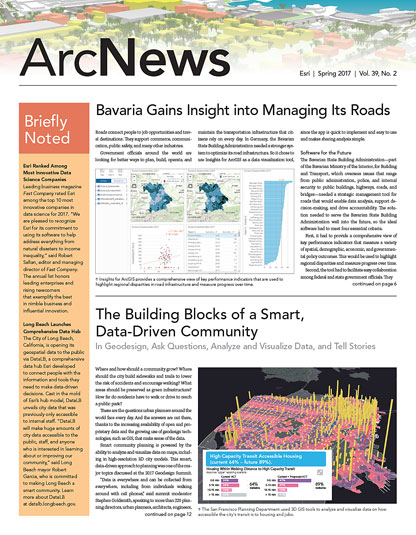With the March update, ArcGIS Online continues to deliver faster and more extensive capabilities, apps focused on personalized solutions, and easier administration tools to strengthen collaboration.
Expanded Operational Capabilities
The scene viewer now offers users the ability to scale geometry by emphasizing height and keeping the other axes constant. When entering a uniform size for all the 3D objects in a point layer, users can select which real-world units—such as meters or feet—to use to size their 3D objects. They can also choose the color of a style symbol such as a car, a house, or an airplane. There are new labeling options as well that allow users to position and adjust labels. They can also select point cloud scene layer points and zoom to and rotate around them. The scene viewer supports touch navigation with touch-enabled computer screens as well.
Route analysis now has better directions, which include the ability to specify line barriers. Users can deploy these barriers to represent temporary route restrictions, such as street closures during a large event or construction project.
A Planet of Content
The World Imagery basemap has been updated with 2016 National Agriculture Imagery Program (NAIP) aerial imagery for several states in the United States, DigitalGlobe satellite imagery for numerous countries in Europe and Asia, and detailed imagery for many metropolitan areas around the world.
Other map updates include detailed demographic data for Japan; traffic count data for the United States; and the latest Michael Bauer Research (MBR) demographic data for more than 35 countries, including Austria, Brazil, Greece, Ireland, Portugal, and Turkey.
Apps Become More Personal
To help organizations apply consistent branding (colors and logos) to their information products, ArcGIS Online administrators can now deploy a shared theme for configurable apps and ArcGIS Open Data sites created by members of their organization. Authors of Esri Story Map Journal, Story Map Series, and Story Map Shortlist (in beta) apps can let readers find addresses, places, and features by implementing a search bar. Story Map Cascade, which has enhanced image galleries and 3D performance, is also available in all supported languages. The Time Aware configurable app template, which allows users to visualize time-enabled layers with a time slider, now supports including future dates in sets (for live weather forecasts, for example). As part of Esri’s effort to design web products that align with Web Content Accessibility Guidelines 2.0, users can also interact with the time slider via the keyboard.
With Crowdsource Reporter—used to collect citizen information on issues and events—users can reorder the details, attachments, and location sections of the submission form. They can also load the app onto mobile devices and see a map view of existing reports instead of a list view. The update to GeoPlanner for ArcGIS enables users to visualize data in 3D so they can better evaluate specific scenarios. This 3D mode allows users to publish features, model shadows, view perspectives by date and time, and evaluate a scenario’s potential impact by looking at key performance indicators.
Esri’s Apps for the Field and Apps for the Office continue to become more powerful as well. For Android users, Collector for ArcGIS is now better integrated with Navigator for ArcGIS and Workforce for ArcGIS. Fieldworkers with Android devices can use Workforce for ArcGIS on their mobile phones and tablets as well. And Workforce dispatchers can disable clustering, identify workers more easily, and see which crew members are closest to a particular assignment.
Users of Survey123 for ArcGIS can now build surveys on top of existing hosted feature services, as well as log in from social media accounts, including Facebook and Google. Survey results can also be shared with stakeholders via the Survey123 website.
ArcGIS Maps for Office, which gives Microsoft Excel spreadsheet users the ability to visualize tabular data, is now faster with an integrated Chromium-based browser. It also supports vector basemaps that look even better on high-resolution screens. And users can select items on a map and export the corresponding rows of data to a new Excel workbook or worksheet.
Enhancements to the ArcGIS Business Analyst Web App include more powerful suitability analysis with competitive layers and better support for site attributes, improved infographics with support for adding location pictures and attributes and using proprietary data, and updates for 32 countries in Western and Eastern Europe.
Taking Care of Administrative Business
ArcGIS Online administrators can now more easily control the content a user can access. New privileges allow administrators to decide who should have view-only access to organization members, content shared within the organization, and groups shared with the organization. This way, some members can only view the content shared with them through groups they belong to.
Users who have multiple accounts for ArcGIS Online and Esri websites can now link them and switch between accounts, connecting all their Esri customer information—from My Esri, e-Learning courses, and GeoNet, for example. The option to switch accounts is currently available from an organization’s ArcGIS website, the ArcGIS Online website (for public accounts), and Esri websites.
To learn more about the March updates to ArcGIS Online, visit the ArcGIS Online What’s New page and check out the ArcGIS Online blog.

